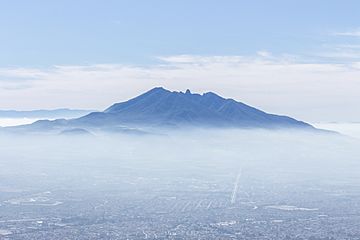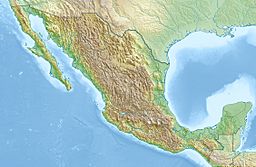Sangangüey facts for kids
Quick facts for kids Volcán Sangangüey |
|
|---|---|
 |
|
| Highest point | |
| Elevation | 2,340 m (7,680 ft) |
| Geography | |
| Parent range | Trans-Mexican Volcanic Belt |
| Geology | |
| Mountain type | Stratovolcano |
| Last eruption | Unknown (possibly 1742) |
Sangangüey is a large volcano in Mexico. It stands 2,340 meters (about 7,677 feet) tall. This volcano is located in the state of Nayarit, near the city of Tepic. Sangangüey is part of a long chain of volcanoes called the Trans-Mexican Volcanic Belt.
Over many years, wind and rain have worn down parts of Sangangüey. This is why it is called an "eroded" volcano.
Contents
About Sangangüey Volcano
Sangangüey is known as a stratovolcano. These volcanoes are usually tall and cone-shaped. They are built up over time by many layers of hardened lava, ash, and rocks.
Where is Sangangüey located?
You can find Sangangüey in western Mexico. It is in the state of Nayarit, which is on the Pacific coast. The volcano sits just southeast of Tepic, the capital city of Nayarit.
Has Sangangüey erupted recently?
Scientists have not confirmed any eruptions from Sangangüey in modern history. However, there is an old local story. An Indian legend says the volcano erupted in the year 1742. It is thought that this eruption might have happened from a smaller cone on the side of the main volcano. These smaller cones are called cinder cones.
Even though there are no confirmed recent eruptions, Sangangüey has been active in the past. Over the last 300,000 years, this volcano has created many smaller cinder cones. It has also produced many lava flows around its base.
See also
 In Spanish: Sangangüey para niños
In Spanish: Sangangüey para niños


